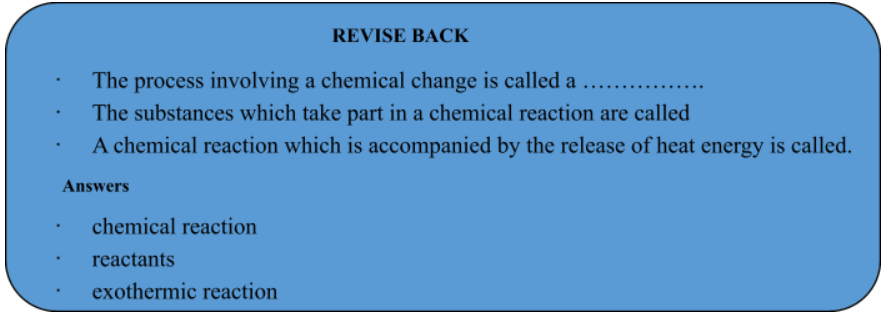
Characteristics Of Chemical Reaction
Chemical Reaction And Equation of Class 10
When we heat sugar crystals they melt and on further heating they give steamy vapour, leaving behind brownish black mass. On cooling no sugar crystals appears. Thus change which takes place on heating sugar is a chemical change and the process which brings about this chemical change is called chemical reaction.
- In this reaction the substances which take part in bringing about chemical change are called reactants.
- The substances which are produced as a result of chemical change are called products.
- These reactions involve breaking and making of chemical bonds.
- Product(s) of the reaction is/are new substances with new name(s) and chemical formula.
- It is often difficult or impossible to reverse a chemical reaction.
- Properties of products formed during a chemical reaction are different from those of the reactants.
- Apart from heat other forms of energies are light and electricity which are also used in carrying out chemical changes.
In all chemical reactions, the transformation from reactants to products is accompanied by various characteristics, which are-
Evolution of gas: Some chemical reactions are characterized by evolution of a gas.
- When zinc metal is treated with dilute sulphuric acid, hydrogen gas is evolved. The hydrogen gas burns with a pop sound.
Zn (s) + H 2 SO 4 (dilute) → ZnSO 4 (aq) + H 2 (g)
- When washing soda is treated with hydrochloric acid, it gives off colorless gas with lots of effervescence.
Na 2 CO 3 (s) + 2HCI → 2NaCI (aq) + H 2 O(I) + CO 2 (g)
- 2NaHCO 3 (s) → Na 2 SO 3 (s) + H 2 O + CO 2 (g)
Sodium hydrogen Sodium carbonate Water Carbon dioxide
carbonate
Change of colour: Certain chemical reactions are characterized by the change in colour of reacting substance.
- When red lead oxide is heated strongly it forms yellow coloured lead monoxide and gives off oxygen gas.
2Pb 3 O 4 (s) → 6PbO(s) + O 2 (g)
Lead oxide Lead monoxide
(Red) (Yellow)
- When copper carbonate (green) is heated strongly it leaves behind a black residue.
CuCO 3 (s) → CuO(s) + CO 2 (g)
Copper carbonate Copper oxide Carbon dioxide
(Green) (Black)
- 2Pb(NO 3 ) 2 (s) → 2 PbO(s) + 4NO 2 (g) + O 2 (g)
Lead (II) nitrate Lead (II) oxide Nitrogen dioxide
(White) (Yellow) (Brown)
- C 12 H 22 O 11 (s) → 12C(s) + 11H 2 O
White sugar Carbon Black Water
Formation of precipitate : Some chemical reactions are characterized by the formation of precipitate (an insoluble substance), when the solutions of the soluble chemical compounds are mixed together.
- When silver nitrate solution is mixed with a solution of sodium chloride.
AgNO 3 (aq) + NaCI (aq) → NaNO 3 (aq) + AgCI (s)
Silver nitrate Sodium chloride Sodium nitrate Silver chloride
(Colourless) (Colourless) (Colourless) (White precipitate)
A dirty green precipitate of ferrous hydroxide is formed, when a solution of ferrous sulphate is mixed with sodium hydroxide solution.
- FeSO 4 (aq) + 2NaOH(aq) → Na 2 SO 4 (aq) + Fe(OH) 2 (aq)
Ferrous sulphate sodium hydroxide Sodium sulpahte Ferrous hydroxide
(Light green) (Colourless) (Colourless) (Dirty green precipitate)
- BaCl 2 (aq) + dill H 2 SO 4 → BaSO 4 (s) + 2HCI (aq)
Barium chloride Barium sulphate
(White precipitate)
Energy changes: All chemical reactions proceed either with the absorption or release of energy.
On the basis of energy changes, there are two types of reactions:
(A) Endothermic reaction: A chemical reaction which is accompanied by the absorption of heat energy is called an endothermic reaction.
C (s) + 2S (s) → CS2
- Light energy is essential for biochemical reaction, photosynthesis, by which green plants prepare their food from carbon dioxide & water.
(B) Exothermic reaction: A chemical reaction which is accompanied by the release of heat energy is called exothermic reaction.
When magnesium wire is heated from its tip in a bunsen flame, it catches fire and burns with a dazzling white flame with release of heat and light energy.
2Mg (s) + O 2 (g) → 2MgO (s) + Energy
- When quick lime (calcium oxide) is placed in water, the water becomes very hot and sometimes starts boiling. It is because of release of heat energy during the reaction.
CaO (s) + H 2 O → Ca(OH) 2 (aq) + Heat energy
Calcium oxide Water Calcium hydroxide
Change of state: Some chemical reactions are characterised by a change in state i.e. solid, liquid or gas
- Two volumes of hydrogen gas reacts with one volume of oxygen gas to from water.
2H 2 ( g) + O 2 (g) → 2H 2 O
or when electric current is passed through water it splits into its elements.
2H 2 O → 2H 2 (g) + O 2 (g)
NH 3 (g) + HCI (g) → NH 4 CI (s)
Ammonia Hydrochloric acid Ammonium Chloride










